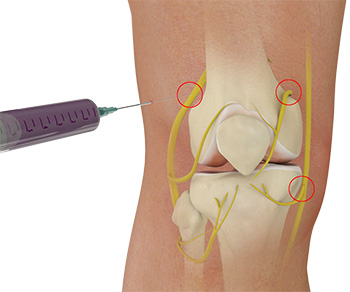What is an Ultrasound-guided Genicular Nerve Block?
The genicular nerves are nerves surrounding your knee joint that are responsible for the transmission of pain impulses. Knee disorders causing excessive pain can be treated by blocking the genicular nerves from transmitting nerve impulses. The procedure may be performed under the guidance of ultrasound imaging.
X-ray was initially used for imaging of the damaged knee while performing the nerve block. Using the ultrasound technique avoids exposure to harmful rays. It is also fast and convenient and improves the accuracy of the block.

Indications for Ultrasound-Guided Genicular Nerve Block
An ultrasound-guided genicular nerve block may be recommended for:
- Osteoarthritis
- Degenerative Joint Disease
- Those unable to undergo surgery
- Those who want to avoid long-term use of medications
- Partial or total knee replacement (Before or after)
Your doctor may not recommend this technique if you:
- Are pregnant
- Have a systemic or local bacterial infection
- Take blood-thinning medications
- Have cancer
What is Knee Osteoarthritis?
Osteoarthritis is a joint condition which results due to the breakdown of cartilage. In the absence of cartilage, the bones rub against each other during movement causing pain. It usually occurs due to aging, obesity, and heredity.
More than 25 million people in the U.S are suffering from osteoarthritis, the most common being knee osteoarthritis.
Initially, your doctor will suggest conservative methods such as medications and corticosteroids injections to treat pain and its associated symptoms. The long-term use of injections, however, is associated with the death of healthy tissue around your knees and infections.
Arthroscopic surgery may also be recommended to remove the damaged part of the cartilage which is causing pain.
Procedure for Ultrasound-Guided Genicular Nerve Block
An ultrasound-guided genicular nerve block involves the following steps:
- The area around your knee is cleaned
- Your surgeon uses an ultrasound transducer to locate and image the genicular nerves
- You are given local anesthesia
- The needle is advanced to the nerve under ultrasound guidance
- The nerve block is performed by injecting a mixture of a steroid and anesthetic
- The needle is then removed followed by application of a bandage
Following the procedure, you may be kept under observation for a few hours. Do not perform any strenuous activities for a few days. If you have significant pain relief with an ultrasound-guided genicular nerve block, your doctor may recommend a radiofrequency ablation of the nerves for long-term relief.
Complications
There are no serious complications associated with the procedure. Allergy and infection at the needle entry site may occur in a few patients.






